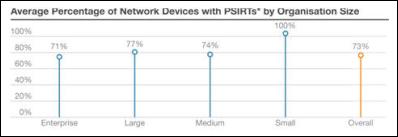NZ Network Infrastructure Not Business Ready
News Release
Network
Infrastructure Not Business ReadyMultiple
issues found with configurations, security vulnerabilities
and end-of-life status
See also…
NetworkBarometerReportFactSheet1.pdf
DimensionDataNetworkBarometerReport2009.pdf
Poor
network management and basic security vulnerability
oversights are leaving organisations open to security
attacks, compliance breaches and operational
downtime.
This is one of the key findings in the Network Barometer Report launched today by Dimension Data, the $4.5 billion IT solutions and services provider. Datacraft is a wholly owned subsidiary of Dimension Data. The Report presents the aggregate data from 152 Secure Network Infrastructure Assessments (SNIAs) conducted by Dimension Data for organisations around the world during 2008, and provides an overview of networks’ configuration, security vulnerabilities and device life-cycle status.
The
results provide a revealing view into networks and their
common problems, errors and obstacles to success:
• 73%
of deployed IOS versions have known security
vulnerabilities.
• There is an average of 15 security
best practice configuration errors per device deployed,
despite widely published and recommended standards.
• 43% of all equipment reviewed has entered the
end-of-life cycle, and of this group, 56% is either beyond
end-of-software maintenance or last-day-of-support.
Security vulnerabilities
According to the Report, 73%
of networking devices have known security vulnerabilities
which expose a business to both external and internal
security attacks and breaches, and which could have
significant implications for regulatory compliance.
Dexter Wee, General Manager, Network Integration of Datacraft Asia says, “Organisations are running with vulnerabilities they’re probably not aware of. The results also indicate that there’s a lack of process to remediate these vulnerabilities.”
And that’s not all. For many sectors, non-compliance can result in considerable penalties. For example, merchants may be excluded from the credit card companies that their business transactions rely on. This means data leaks and compliance failures, along with natural disasters and market crashes, are issues which should rank high on executives’ risk list.
Configuration errors
The research also showed that an
average of 15 security configuration errors were found per
device deployed – despite widely published and recommended
standards.
“These results are astounding,” says Wee. “The most basic protection measures against threats which could harm an organisation, such as access and password configurations, are simply not in place. It’s the functional equivalent to leaving the doors and windows unlocked when you leave home,” he explains.
End of Life cycle
The
Report also reveals that 43% of all equipment reviewed had
entered the first end-of-life cycle stage, and of that
group, 56% was beyond either end-of-software maintenance or
last-day-of-support. Ageing IT and network assets, depending
on their functions, will become increasingly unsupportable
and open to risk, leaving the organisation exposed to
potential availability and mean-time-to-repair risks.
Additional commercial implications
arise when an end-of-life device fails and must be replaced.
Businesses may then have to buy expensive technology in
compressed timeframes, without the customary due diligence
which ought to be applied in such procurement decisions.
“Today, organisations depend on the functionality,
availability and successful management of their IT networks.
Indeed, many companies would simply not function without the
technologies that enable their business processes,” says
Wee. “Given this dependency, the basics of keeping
networks running and ‘ready for business’ should be a
priority for most organisations.”
“As such, rigorous network asset planning is crucial in working out a roadmap of which technology requires replacing down the line. This can realise cost savings, streamline processes and improve productivity – all competitive advantages that are critical to organisations in the current economic climate.”
The Dimension Data Network Barometer Report is attached for your reference. For more information, please go to www.datacraft-asia.com/networkbarometer
*PSIRT = APSIRT is a software vulnerability that has been identified by Cisco’s Product Security Incident Response Team
-Ends-
About
Datacraft
Datacraft is a wholly owned subsidiary
of Dimension Data plc (LSE:DDT), a US$4.5 billion leading
global IT solutions and services provider. Datacraft
operates in over 50 offices across 13 Asia Pacific
countries. We help clients plan, build, support, manage,
improve and innovate their IT infrastructures. Datacraft
combines an expertise in networking, security, data centre,
storage, Microsoft solutions and contact centre
technologies, with advanced skills in consulting,
integration, training and managed services to craft IT
solutions for businesses. For more information, please visit
www.datacraft-asia.com.
About
the Dimension Data Network Barometer Report
The
Network Barometer Report presents the aggregate data from
152 Secure Network Infrastructure Assessments (SNIAs)
conducted by Dimension Data for organisations around the
world during 2008. The Report provides an overview of
networks’ configuration, security vulnerabilities, and
device life-cycle status. The Report is also available for
download from www.datacraft-asia.com/networkbarometer.
ENDS




 Stats NZ: Total Greenhouse Gas Emissions Fall 0.7 Percent In The September 2024 Quarter
Stats NZ: Total Greenhouse Gas Emissions Fall 0.7 Percent In The September 2024 Quarter Takapuna Beach Business Association: Takapuna Outpaces Auckland With Strong Economic Growth In 2024
Takapuna Beach Business Association: Takapuna Outpaces Auckland With Strong Economic Growth In 2024 Commerce Commission: Bed, Bath And Beyond Sentenced Over Record Number Of Unsafe Products
Commerce Commission: Bed, Bath And Beyond Sentenced Over Record Number Of Unsafe Products GE Free NZ: Minister Reti Asked For Two Week Delay Of Select Committee Deadline
GE Free NZ: Minister Reti Asked For Two Week Delay Of Select Committee Deadline Science Media Centre: Government Plans To Double Mineral Exports By 2035 – Expert Reaction
Science Media Centre: Government Plans To Double Mineral Exports By 2035 – Expert Reaction University of Canterbury: AI-powered Tool To Combat Rising Wildfire Danger
University of Canterbury: AI-powered Tool To Combat Rising Wildfire Danger



